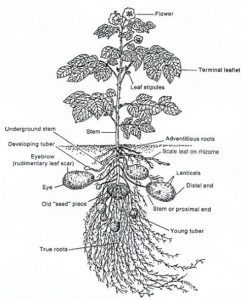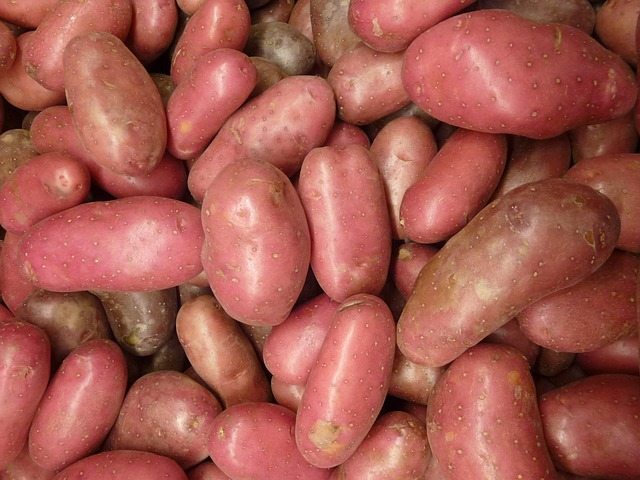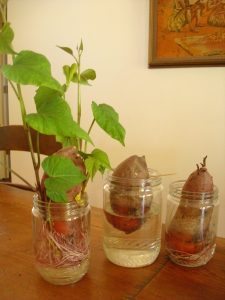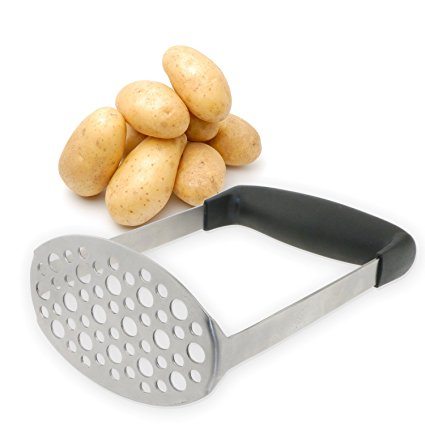 Potatoes are one excellent staple crop to grow in the home garden, but isn’t there a lot of digging and back pain involved?
Potatoes are one excellent staple crop to grow in the home garden, but isn’t there a lot of digging and back pain involved?
Not necessarily! You can grow loads of russets, reds, golds, and even sweet potatoes in a trash can or bucket with minimal work, space, and effort.
It’s common to get up to 25 pounds of potatoes using this method, and it’s really simple too! This takes container gardening to another level.
The perfect bucket for growing any type of potato will have some sort of drainage holes drilled into the bottom–or, you can even cut the entire bottom out. That way, instead of dumping the bucket out to harvest your potatoes, you can just lift it up and they’ll fall out.
A metal or dark-colored can is preferred, to retain warmth and keep sunlight away from the root zone.
The how-to is slightly different for sweet potatoes and regular potatoes, so I’ll talk about regular potatoes first:

Basically, any organic potato you’ve already got will work perfectly as a seed potato. Ideally, they’ll be a bit past their prime for eating, and will have some eyes starting to form.
Don’t cut the potatoes up to look for seeds inside, because you won’t find any! (I once met someone who did this; you’re not alone.)
Instead, cut them into quarters, ideally with at least one “eye” on each piece. Allow these to dry out on the counter for a day or two before planting them.
These potato pieces will be planted cut-side down into your trash can or bucket, and each one will start growing into a new plant.
If you’re growing sweet potatoes, you can buy some organic ones at the grocery store to start your plants with–maybe just one or two.
 This time, you’ll want to begin by doing that toothpick-balancing trick that you probably did as a science project in grade school.
This time, you’ll want to begin by doing that toothpick-balancing trick that you probably did as a science project in grade school.
Spear the sweet potato around the middle with four toothpicks, and balance it in a glass or jar of water. The sweet potato should be at least halfway submerged. You’ll want to add more water every few days to maintain this level.
Eventually, your potato will sprout stems and leaves, and these are called “slips”.
You’ll cut off these slips with a small sliver of the potato attached, and plant the slips into your trash can or bucket.
How to plant your potato “seeds” and/or “slips”:
Fill your trash can or bucket with about 8-12 inches of compost, and add in your seeds or slips. For white potatoes, bury the seeds with about an inch of compost. For the slips, plant them sideways about an inch down, leaving a few leaves and an inch or so of stem exposed.
 Get a TedGem Stainless Steel Potato Masher on Amazon!
Get a TedGem Stainless Steel Potato Masher on Amazon!
As the plants grow, add more compost. You’ll want to keep burying the new growth until only a few leaves remain exposed, about 4-5 inches of compost for every 7-10 inches of growth.
Burying the stems forces plants to generate new root growth (in other words, potatoes!).
Keep them well-watered, and be patient. The whole process will take about four months.
When your trash can is full to the brim, simply continue to water it. The plants will eventually start to flower, and soon after, the whole plant will start to wilt, yellow, and die back.
Stop watering them at this point. This allows your potatoes to mature, which will take about two weeks until they’re ready to harvest.

With sweet potatoes, you’ll want to harvest them as soon as the leaves wilt and blacken from frost.
Then you’ll need to let the sweet potatoes cure for two weeks or more, in a dark, cool, dry place. This will ensure their sweet flavor, and allows them to be stored at room temperature for up to a year!
Incidentally, sweet potato greens are also edible and delicious when prepared like cooked spinach. They’re also pretty in urban landscapes!
Growing potatoes in this way can be a excellent supplement to your food bill, and a great DIY skill to learn.
 Get the book here on Amazon!
Get the book here on Amazon!




